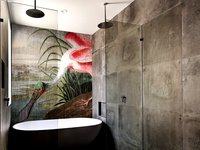HVAC APPLICATIONS
HVAC APPLICATIONS
The legislative and standard framework for building design has evolved profoundly since
the early 2000s. The European Union has drawn attention to the fact that buildings are
responsible for 40% of final energy consumption - and 75% of them are still energy
inefficient - requiring Member States to make a major recovery of efficiency through
mandatory transposition directives. On the other hand, this action must not decrease
the comfort and well-being of the end-users of buildings, also considering the high
proportion of time spent indoors. The concept of Indoor Environmental Quality (IEQ)
has therefore been affirmed, underlining the importance of ensuring high environmental
quality within confined spaces, together with the recovery of energy efficiency.
This is a comprehensive approach in four dimensions:
- thermo-hygrometric comfort;
- air quality;
- visual comfort;
- acoustic comfort.
The first two dimensions are representative of the Indoor Climate Quality (ICQ) and are
directly influenced by the heating, cooling, dehumidification, air renewal and ventilation
systems and by the functions carried out by the building automation and control system.
In 2008, the IEQ concepts were recognised with the publication of EN 15251 standard,
which was replaced in 2019 by EN 16798-1 standard.
References
EN 16798-1:2019 Energy performance of buildings. Ventilation for buildings. Indoor
environmental input parameters for design and assessment of energy performance of
buildings addressing indoor air quality, thermal environment, lighting and acoustics -
Module M1-6
Indoor environmental quality (IEQ)
Indoor Climatic Quality (ICQ)
There are many parameters that influence indoor climate quality (ICQ); as a first
approximation, they can be grouped into three categories.
- Temperature and relative humidity mainly concern the thermo-hygrometric comfort
and the well-being felt by the end-users of a building. In moderate thermal rooms these
parameters do not have an impact on human health.
- CO2 is mostly produced by breathing people and animals, but it is only harmful above
very high concentrations that are usually not reached inside buildings. However, a high
concentration of CO2 in confined spaces negatively affects people’s productivity and
cognitive abilities; this parameter is often used as a reference for evaluating the quality
of the room air mass.
- The actual pollutants can instead have consequences on human health; the extent
varies and ranges from simple olfactory stress and headaches, through biological
effects such as irritation and allergic reactions, to serious diseases in case of very
prolonged exposure. Pollutants can be divided into two categories according to their
origin: internal or external. Due to the inevitable exchange of air between outside and
inside, external pollutants are generally also detectable inside. Indoor pollutants are
numerous and heterogeneous, but particular attention should be paid to Volatile Organic
Compounds (VOCs) and airborne dust (PM or Particulate Matter). Many synthetic
substances introduced on the market in recent decades belong to the VOC class and
for most of these there is still not enough information to determine their hazardousness.
Comfort
Temperature
Relative
humidity
Presence
CO2
Pollutants
External
Internal
SO2, O3, Nox, CO
Inorganic
powders
Particulates, VOC
Burning
products
CO and CO2
Artificial
glass fibres
Volatile Organic
Compound (VOC)
Organic
powders
Microbial
agents
Radon
Thermo-hygrometric
comfort
Indoor climatic
comfort (ICQ)
Application field of domotic
and building automation
Indoor Environmental Quality (IEQ)
Air
quality
Visual
comfort
Acoustic
comfort
The monitoring and supervision of technical systems plays a fundamental role in
functional buildings: in fact, it is absolutely essential for users to ensure a high level of
service and maximum continuity of operation of the systems.
Based on the needs of the individual building, the system allows to keep under control
a set of values, parameters, states and quantities relevant to the operation of the several
systems; the comparison with the values of design and reference standards allows
to highlight any anomalies, analyze the deviations and quickly restore the optimal
operation. The inclusion in the system of the signaling of technical alarms is decisive
for the timely intervention of the service and maintenance personnel. The integration
between the monitoring of technical systems and the building automation system offers
the possibility to increase the efficiency in the use of resources, reducing waste, to
exploit the full potential of technical systems, to limit the need for inspections and to
allow a longer life of individual components or complex equipments.
Thanks to centralization and real-time availability of information, it is easier for building
maintenance personnel to identify problems on the synoptic diagrams and then report
them to the technicians responsible for service. This is especially important for facilities
spread across multiple buildings with a multitude of technical rooms and substations.
Monitoring of technical systems
34
35







